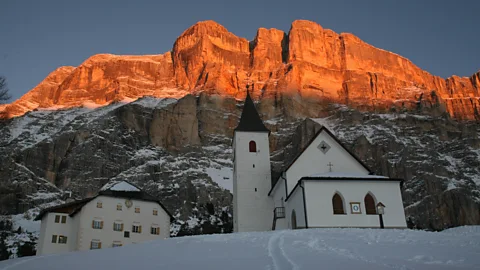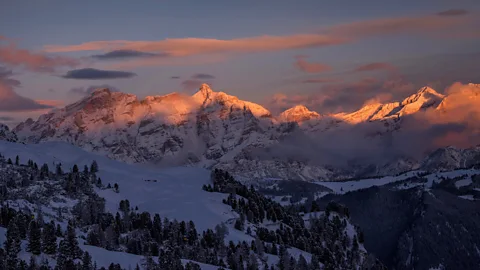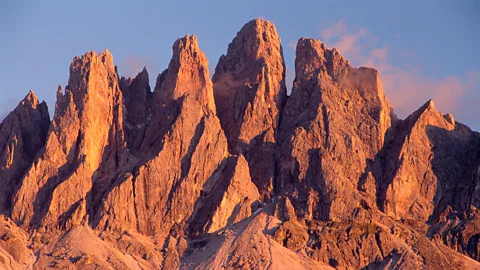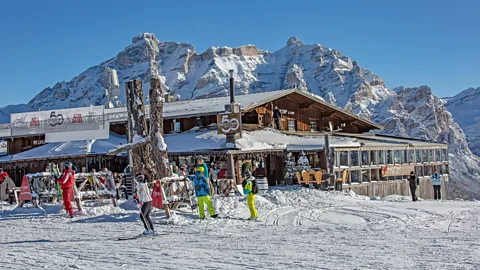What paints the Dolomites pink? The magic of the legendary 'enrosadira'
 Alta Badia
Alta BadiaIn Italy’s Dolomites, the ancient coral peaks glow pink at dawn and dusk in a rare natural phenomenon called the enrosadira – a magical moment that makes skiing here unforgettable.
Maybe it's skiing beneath prehistoric, snow-capped spires or the combination of homemade pasta and Austrian apple strudel. But the après-ski scene just hits differently in Italy's Dolomite Mountains – and the "enrosadira" certainly has something to do with it.
This rare natural phenomenon washes over the Dolomites at dawn and dusk when the sun's rays reflect off the craggy peaks in steamy shades of hot pink and wildfire red. The revered towers and cliffs illuminate, transporting visitors back to when the ancient Unesco World Heritage-listed mountains were a coral reef ascending from the sea. And soon, these spectacular sunsets will light up for the entire world when the Dolomites co-host the Milano Cortina 2026 Olympics and Paralympics. But for now, you can still catch this wild, blushing beauty without all the crowds.
It's no surprise that enrosadira translates to "turning pink" in the Dolomites' ancient Ladin language (the world's last spoken Latin dialect). Like many Ladin traditions, tales of these mountains have been passed down for centuries. According to local legend, the magenta, amber and violet-tinged-bedrock that arrives every morning and evening is what's left of an elf king's beloved rose garden after his daughter was taken away by a suitor. Broken-hearted, he cast a spell forbidding anyone from seeing the beauty of his magical rose garden in the light of day again – only he left out daybreak and twilight.
"Enrosadira is deeply rooted in our Ladin tradition and linked to legends, emotions and a strong sense of belonging to the land," says Nicole Dorigo, a Ladin living in the Dolomites' Alta Badia region in the southern part of the Tyrol valley. "The play of lights on the mountains creates a magical and evocative atmosphere, conveying a sense of peace and connection with our homeland and the natural beauty that surrounds us."
 Alta Badia
Alta BadiaOf course, the vibrant rock hues can also be explained by science. Back in the 1700s, French geologist Deodat de Dolomieu discovered that the range's peaks aren't pure limestone, as many previously believed. They're made of dolomite – a rock formed millions of years ago in a continental collision that uprooted the coral reef and islands between Africa and Europe. Magnesium-rich seawater slowly transformed the limestone reefs into a pale gray and tan sediment that reflects and re-emits more light than regular limestone, explaining why these mountains shine so brightly and vividly.
The Best of 2025
The Italian Dolomites was named one of BBC Travel's 25 best places to visit in 2025, a list highlighting destinations that are not only welcoming visitors, but using tourism as a force for good. See the full list here.
"The dolomite layers were all covered by the sea in ancient times. All the sediment from the fish and mud became concrete when the water flooded around it, forming many unique rock shapes," says Andrea Milani, a climbing and ski guide for Dolomite Mountains tours. "In the morning and evening when the sun goes down, with a clear sky, the mountains turn pink."
Today these ancient sea beds have become one of the world's premier ski regions, offering 12 interconnected Dolomiti Superski resorts. So, after a day on the slopes, over long, deep snowy peaks and valleys where tectonic plates once collided, pull up a lawn chair and watch the sun rays reflect an intense mauve and deep orange. For the best show, face west at sunset or east at sunrise under a clear sky. The lower the sun sits on the horizon, the more dramatic the colours.
Apres-ski doesn't get better than Aperol spritz under enrosadira in crisp mountain air – unless you're lucky enough to find a fossilised seashell in the snow. Here are some of the best après-ski spots to watch the Dolomites blush pink:
 Alamy
AlamyCyprianerhof Dolomit Resort, Tires Valley
Sip an apéritif on the terrace of this luxury South Tyrolean hotel overlooking the famous Catinaccio (also called Rosengarten) mountains – the mythical setting of Ladin king Laurin's rose garden. In real life, these mountains frame Alpine meadows with a 17th-Century chapel, an old watermill and nature park. After your après-ski sunset experience, dine at the resort's restaurant on fresh, regionally inspired fare.
Delights On Ice, Badia
On a candlelit Lake Sompunt, nestled between the towering mastiffs, lies Delights On Ice where tuxedoed servers on figure skates bring you Champagne, wowing you with waltz jumps, sizzles and glides as this small frozen pond reflects the rose-colored peaks at sunset. As sommeliers pour Teroldego and other South Tyrolean wines, local chefs dazzle with traditional Italian, German, Austrian and Ladin dishes like homemade silky polenta and spicy goulash. Tickets are available at the Alta Badia tourism office.
More like this:
• A downhill ski champion's guide to Cortina d'Ampezzo, Italy
Club Moritzino, La Villa
Club Moritzino is one of the Dolomites' top spots – both in elevation at 2.05km and for après-ski – and has been the life of the party for more than 50 years. Here, at the summit of La Villa's Piz La Ila cable car, you get 360-degree mountain views at a gourmet restaurant, wine bar and with an afternoon DJ out on the terrace.
 Alta Badia
Alta BadiaChalet Tofane, Cortina d'Ampezzo
Located at the base of the 2026 Winter Olympics Alpine ski slope, Chalet Tofane is convenient both to the slopes and the rest of Cortina's upcoming Olympic in-town events: bobsleigh, luge, skeleton and curling. Take a seat on the stylish roof deck to watch the sunset and order the Northern Italian favourite drink, the bombardino (a hot, creamy cocktail made from egg liquor, brandy and topped with whipped cream and cinnamon).
Ristorante La Stua Après Ski, Val Gardena
After skiing the famous Sellaronda ski route across four Ladin valleys, finish the day at La Stua. Translated from Ladin as "wooden living room", this cosy restaurant with outdoor seating is perfect for watching the enrosadira. And if you want to get a little rowdy, this 1800s farm hut (the Dolomites are home to over 1,000 of these "rifugi") has an apres-ski party that won't stop until 02:00. Need a place to stay? Head to the nearby Adler Resort, where you can also watch the sunset from the Lodge before partaking in a rejuvenating spa treatment.
--
If you liked this story, sign up for The Essential List newsletter – a handpicked selection of features, videos and can't-miss news, delivered to your inbox twice a week.
